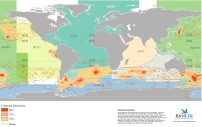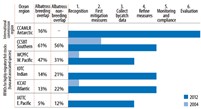
Under the UN Fish Stocks Agreement, states have a duty to reduce the bycatch of seabirds in their fisheries. Since 2004, BirdLife (especially through the ‘Save the Albatross Campaign’) has been working to ensure global fishery management organisations take effective action to reduce the number of birds killed in their fisheries.

Albatrosses are one of the most threatened families of birds in the world, with 17 of the 22 species of albatross listed as globally threatened. The key threat to the majority of albatross species is being caught and killed as bycatch in fisheries. Under the Law of the Sea and the associated ‘UN Fish Stocks Agreement’, states have a duty to minimise the bycatch of vulnerable species such as albatrosses in their fisheries. Since 2004, BirdLife (especially through the ‘Save the Albatross Campaign’) has been working to ensure global fisheries take effective action to reduce the number of birds being killed.
A key avenue is through Regional Fisheries Management Organisations (RFMOs), the organisations through which states manage high seas and migratory fish stocks. In 2004, BirdLife conducted the first-ever environmental review of the world’s RFMOs (Small 2005). In the Southern Ocean, CCAMLR (the Commission for the Conservation of Antarctic Living Marine Resources) has demonstrated what can be achieved, having reduced albatross bycatch by over 99% in its fisheries around South Georgia. However, over 80% of global albatross distribution is outside CCAMLR waters, overlapping mainly with tuna and swordfish fisheries, which are managed by the world’s five tuna commissions (see figure a). In contrast to CCAMLR, in 2004 only one of the five tuna commissions had any requirements for vessels to reduce seabird bycatch.

Effective action to reduce seabird bycatch involves five key steps: recognising the problem, setting requirements for mitigation measures, collecting data, establishing systems to monitor compliance, and evaluation and refinement of measures. Since 2004, significant progress has been made in the tuna commissions: all five now have requirements for their longline vessels to use bycatch mitigation measures in areas overlapping with albatrosses, and all five are establishing bycatch data collection programs (see figure b).
The next key steps include ensuring that effectiveness is monitored by targeted observer projects, and that bycatch data are reported and made available for analysis and interpretation. This is vital to ensure that effective action takes place where it matters: at the stern of each fishing vessel. The best-practice standards, as achieved by CCAMLR, need to be implemented by all RFMOs.
Key to acronyms:
Related Case Studies in other sections
References
Compiled: 2008 Last updated: 2013 Copyright: 2013
Recommended Citation:
BirdLife International (2013)
BirdLife is working with Regional Fisheries Management Organisations to reduce albatross declines.
Downloaded from https://datazone.birdlife.org/sowb/casestudy/birdlife-is-working-with-regional-fisheries-management-organisations-to-reduce-albatross-declines on 22/12/2024